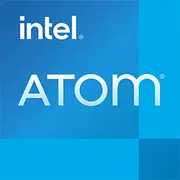Intel Atom x5-E3930

Intel Atom x5-E3930: Low-Power Processor for Basic Tasks - 2025 Review
Architecture and Process Technology: Apollo Lake on 14 nm
The Intel Atom x5-E3930, released in 2016, belongs to the Apollo Lake line designed for budget laptops, tablets, and compact PCs. Despite its age, it can still be found in ultra-budget devices, especially in developing markets.
Key CPU Specifications
- Cores and Threads: 2 cores, 2 threads (no Hyper-Threading).
- Frequencies: Base frequency - 1.3 GHz, maximum in turbo mode - 1.8 GHz.
- Cache: 2 MB L2 cache.
- Process Technology: 14 nm (FinFET), which was a progressive solution for its time.
Integrated Graphics HD Graphics 500
- Execution Units (EU): 12 EU.
- GPU Frequency: 400 MHz (base), up to 600 MHz in turbo.
- Support for Standards: DirectX 12, OpenGL 4.4, 4K video output via HDMI 2.0.
The Apollo Lake architecture is optimized for energy efficiency, but not for performance. It supports DDR3L/LPDDR3 and eMMC storage, which lowers device costs.
Power Consumption and TDP: 7 W for Compact Devices
TDP (Thermal Design Power): 7 W. This allows the processor to be used in passive cooling systems (without fans) or in enclosures less than 10 mm thick.
Power Consumption Features:
- Power-saving modes: Intel SpeedStep (dynamic frequency adjustment), C-states (turning off unused blocks).
- Support for S0ix (Modern Standby) - quick wake-up from sleep, like in smartphones.
These parameters make the x5-E3930 ideal for devices with a 25–35 Wh battery, where battery life is more important than power.
Performance: Modest Results Even for Basic Tasks
Office Work and Web Surfing
- Examples: Google Docs, Microsoft Office, 5–10 tabs in Chrome.
- Results: The processor handles simple tasks but starts to lag when multiple applications are run simultaneously. For instance, opening an Excel file with 10,000 rows takes 4-5 seconds.
Multimedia
- Video: Smooth playback of Full HD (60 FPS) and 4K (24 FPS) thanks to decoding of VP9 and H.265.
- Audio: Supports HD audio, but insufficient resources for sound processing in DAW (e.g., Audacity).
Gaming
- Integrated HD 500 Graphics: Can only run older games at low settings:
- Counter-Strike: Global Offensive - 20–25 FPS (720p, minimum settings).
- Minecraft - 25–30 FPS (without shaders).
- Turbo mode provides up to a 15% boost, but due to thermal limitations, it lasts only 1–2 minutes.
Use Cases: Who is the x5-E3930 Made For?
1. Budget Laptops and Netbooks: Devices priced at $200–$300 (e.g., Chuwi MiniBook or ASUS VivoBook E203).
2. Educational Gadgets: Laptops for students, electronic textbooks.
3. Portable Media Centers: Devices for video streaming (e.g., mini-PCs with HDMI).
4. IoT Devices: Payment terminals, info kiosks.
Not suitable for:
- Video editing, 3D modeling.
- Modern gaming.
- Multitasking (e.g., streaming + working in Photoshop).
Battery Life: Up to 10 Hours Under Ideal Conditions
- Usage Time: 8–10 hours when using office applications and moderate screen brightness (example: Acer Aspire One with a 36 Wh battery).
- Power-Saving Technologies:
- Display Power Saving Technology (DPST): Automatic contrast adjustment.
- Panel Self Refresh: Reduces CPU load during static images.
- Tip: For maximum battery life, choose laptops with HD (not Full HD) displays and SSDs (instead of eMMC).
Comparison with Competitors: Outdated, but Cheap
AMD Athlon Silver 3050e (2020)
- Pros: 2 cores/4 threads, Vega 3 GPU (30% more powerful than HD 500).
- Cons: TDP 6 W, but worse optimization for Linux.
- Device Prices: Starting from $250.
Apple A12 Bionic (2018, in iPad)
- Pros: 6 cores, neural processor, support for modern apps.
- Cons: Only in tablets, starting price $400.
Intel Celeron N4020 (2019)
- Pros: 2 cores/2 threads, turbo up to 2.8 GHz, TDP 6 W.
- Cons: Laptop prices start from $280.
Conclusion: The Atom x5-E3930 lags behind even budget models from the 2020s but wins on price: devices with it are $50–$80 cheaper than counterparts.
Advantages and Disadvantages: When is the Choice Justified?
Strengths:
- Ultra-low price (new laptops start from $180).
- Passive cooling (complete silence).
- 4K video support.
Weaknesses:
- No support for Wi-Fi 6 or USB-C.
- Maximum 8 GB RAM (often 4 GB).
- Weak upgrade potential: memory and storage are often soldered onto the board.
Recommendations for Laptop Selection: What to Look for?
1. Type of Device:
- Ultra-Budget Laptop: ASUS Laptop E210.
- Mini-PC: Beelink U55.
2. Critical Parameters:
- RAM: Minimum 4 GB (better 8 GB).
- Storage: SSD 128 GB (eMMC significantly slows down the system).
- Screen: Matte panel (for outdoor use).
3. Avoid:
- Versions with HDD instead of eMMC/SSD.
- Devices without warranty (often sold under "no-name" brands).
Final Conclusion: Who is This Processor For?
Intel Atom x5-E3930 in 2025 is a choice for those needing the cheapest device for basic tasks. It is suitable for:
- Students for note-taking and online courses.
- Retirees for communication via messengers.
- As a second laptop for travel.
Key Benefits:
- Price below $200.
- Battery life of up to 10 hours.
- Compactness and noiselessness.
However, for any serious work, it's better to consider models with AMD Athlon Silver or Intel Celeron N-series, which offer significantly better performance for $250–$300.
Basic
CPU Specifications
Memory Specifications
GPU Specifications
Benchmarks
Compared to Other CPU
Share in social media
Or Link To Us
<a href="https://cputronic.com/en/cpu/intel-atom-x5-e3930" target="_blank">Intel Atom x5-E3930</a>